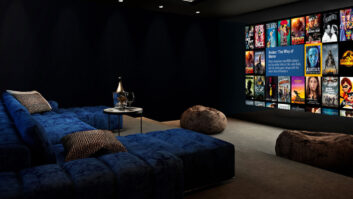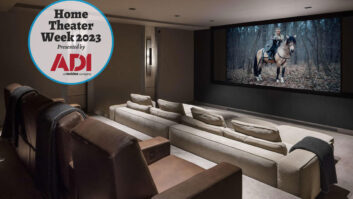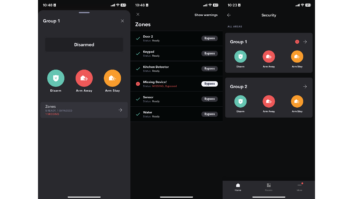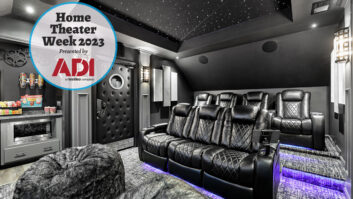My cup runneth over lately with in-home product demos. My latest round of review samples has included HomeLogic’s iPod touch home control interface, Next Generation Home Products’ Remote Control Extender, and Kaleidescape’s Mini System.
Let me start with the Remote Control Extender, because it’s the most straightforward product of the bunch. Industry friend and PR/marketing veteran Peter Hoagland introduced me to Next Generation Home Products president Bob Dolatowski at EHX this past spring, and I was determined to like his product just because Bob was such a nice guy. From the start, however, what should have been a simple add on to my family’s IR remote, wasn’t quite so straightforward.
The product was created as a way to increase a remote control’s range and to enable components to be hidden inside a closet or cabinet. Although it was designed as an end-user, DIY device the Dolatowski has tracked many professional integration sales to dealers who are looking for a problem solver for budget-conscious clients.
Here’s how it works: an RF battery transmitter replaces either one AA or AAA battery inside a consumer’s existing remote control. An RF Receiver, with its built-in RF transmitter recharger, converts the signal from RF to IR and IR emitters run from the transmitter to the devices in the cabinet.

Next Generation Home Products’ Remote Control Extender
After I had charged my transmitter and installed it in my family’s IR remote, my Uverse box didn’t seem to work consistently. Dolatowski quickly realized that he would need to send me a modified transmitter that had been redesigned to work with Verizon’s FiOS TV and AT&T’s Uverse quicker fiber optic systems. Problem solved. His product is, indeed a great little solution for homes where an integrated control system isn’t in the budget or in a guest room that’s “off the grid,” if you will.
Next up in my personal demo alley this month is my review of HomeLogic’s Mobile Control. The new whole-house control app puts users in command of their HomeLogic-controlled home through any Apple iPhone or iPod touch.
This self-installing download is available free from the Apple “App Store,” but HomeLogic’s VP of marketing and sales, Joe Lautner, made it even easier for me by pre-loading the app on an iPod touch for me. All I had to do was pick up the touch, turn it on and click the “HomeLogic Mobile Control” icon on the welcome screen to start experiencing the app’s capabilities within HomeLogic’s demo home in Marblehead, Massachusetts.
I’ve seen lots of demos, including a great touchpanel run through from Lautner at CEDIA EXPO last year, but it was great to have the power in my own hands, from the comfort of my own home. I was able to access live video, which would enable a consumer to queue up a movie by viewing it on their iPhone, iPod touch, or a touchscreen, while watching something else on the main display. When the consumer was ready they could switch the movie to the main display right where they wanted to start.

HomeLogic’s Mobile Control via an iPhone
Lautner pointed out that the feature is convenient for monitoring what kids are watching or for “double dipping” by watching a ballgame (video only) on the control device, while checking out a movie with his wife on the big screen. Like I said, that part of the demo was video only, but HomeLogic’s technology can enable the addition of audio locally in the house. Lautner said that the app has become a very powerful sales driver and makes for a very powerful pocket demo.
Within the demo I was able to turn a light off and on, in real time, and view security cameras in both regular and “landscape” mode. HomeLogic uses Apple’s Accelerometer technology to rotate the image on the device, and I was able to “pinch to zoom” in and out of climate history pages as well. You can also “flick” to move between zones too. It was a great way for me to receive my first introduction to the industry-related Apps that we’ve been writing about for a while now.
Last, but definitely not least was my review of Kaleidescape’s Mini System. Linus Wong from Kaleidescape was kind enough to send me a short-term review sample for my home, which if I’d have wanted I could have even installed into my Middle Atlantic rack. Knowing that I had to send the server back in 10 days, however, I did a quick install in the theater first, watching a couple of movies, then moved the box to the main level where I could live with it every night.
First, I was impressed with how well the design of Kaleidescape’s GUI has held up without much alteration over its five-year run. I was fortunate to experience one of the company’s first demos back in New York during its launch, and the same “cover view” screen they used then looks just as impressive today. At first I got a kick out of the shuffle mode, whereby you move your arrow over a DVD or CD cover and the software surround that selection with similar titles, whether it’s genre, actor, or title similarities. Later, however, I found this feature a little tiresome and switched to the straightforward “list” menu. In a conversation with Wong after my review period had ended, he mentioned that a dealer could adjust the programming of a Kaleidescape server to turn the shuffle feature off.
What is different about the Mini is that it’s much less expensive (albeit with less capacity) than the original Kaleidescape System. The one I tried out would sell for $7,995 with its two storage cartridges (one for the media and another for RAID backup), and the configuration holds 75 DVDs and 825 CDs. Adding another cartridge, however, would only cost another $595, and double the capacity. Not bad, I suppose, compared with the $20,000 price point of the original.

Kaleidescape’s Mini System with cover art in the background
I asked Wong about competition from download services and reminded me that company founder Mike Malcolm actually got into the business to create a download service and found that a hard drive-based model made more sense initially. Just about everyone already knows that even that approach created legal hurdles for the company, but Malcolm keeps moving forward and innovating.
Wong also told me that his company’s demographic research has revealed that the company’s typical customer is a family with children – not a Hollywood actor or director, as one might assume. He said that ease of use has been huge selling feature (and one that I experienced, literally, out of the box), and that parents love being able to block certain content from their kids, but also appreciated the simplicity of the rest of the system in enabling their kids to shuffle through a video collections to be inspired to watch something new just by the cover art they discover.
Other features I enjoyed were the ability to create movie collections for quicker searches of favorite movies (Kaleidescape’s demo featured an “Academy Award Winners” collection), and the ability to pause a movie and find it later in a “paused movie list.” This feature, Wong, explained works well in multiple zones, when an end user wants to move from one room to another while watching the same movie. I also liked being able to tag the start and end of a favorite scene and then store it in a “Favorite Scenes” library. That’s a great one for dealer showrooms, I’m sure. Another nice feature for consumers who load a lot of new content and then watch it later, allows them to find that content is a “New Collections” list.
Although I didn’t spend much time playing with the music library on the Kaleidescape Mini, I learned that the company utilizes the AMG database for metadata and provides a lifetime license to both the movie and music guide for its customers. Because the system connects via Ethernet to the web, updates are continually made to the system, and features are often added. One such addition to the music server was the way classical music is organized. Now those selections can be sorted by composer for the first time, instead just by title or orchestra (artist).
The only thing missing for in my whole Kaleidescape experience was HD video. Wong mentioned that a 1080p player is coming soon, and that Blu-ray titles will eventually be added to the server’s capability. So all is not lost when it comes to 1080p content on the server. I did appreciate, however, how many Cinemascope (2.35:1) movies that Wong and his team loaded on to their demo box. That made for fun viewing on my Screen Research screen in the theater.







